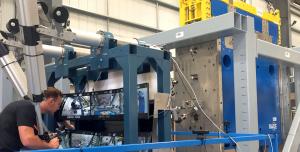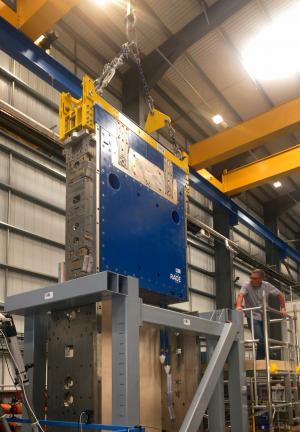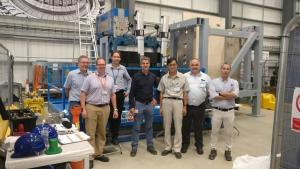Remote handling confirmed
The ITER Organization is putting a number of its planned remote handling activities to the test in a five-year collaboration* with the UK Atomic Energy Authority's RACE facility. The first implementing agreement of the collaboration has concluded successfully.
In a vast workshop in Oxfordshire, after months of fine-tuning, RACE team members successfully carried out two days of demonstrations on a mockup stand that reproduces a small part of ITER—the Hot Cell Complex assembly/disassembly zone where remote maintenance will be carried out on ITER's diagnostic port plugs.
In the presence of ITER Organization witnesses from the remote handling, diagnostics and test breeding blanket sections, the team demonstrated the vertical handling of heavy loads, including removal and insertion to tight tolerances. The goal of the trials was to confirm the compatibility of system designs with planned maintenance solutions, allowing the systems to advance to final design activities and manufacturing.
"For systems requiring remote maintenance and refurbishment it is important that remote handling requirements be taken into account early in the design phase to reduce risk of costly adaptations later," says remote handling engineer David Hamilton, who coordinates the collaboration with RACE. "All participants—ITER Remote Handling as well as ITER system owners—are fully engaged in getting the most value and benefit out of this work."
Many of ITER's diagnostics will be mounted in the port openings of the vacuum vessel, supported within "port plugs" weighing up to 48 tonnes that can be removed from the Tokamak for maintenance. The diagnostic components will be integrated into drawer-like structures—diagnostic shielding modules—each carrying two plasma-facing walls.
Once delivered to the Hot Cell Complex, the port plugs will be supported vertically while maintenance or refurbishment activities are carried out. The task at RACE focused on the insertion/removal of (mock) diagnostic shielding modules from the plug, and the insertion/removal of diagnostic first walls from the shielding modules, using a crane and manipulator arms. The stand faithfully reproduces all the "critical" parts of the operation—the size and weight of the components, for example, and all interfacing features and tolerances as detailed by ITER Organization specifications.
The demonstrations can be considered a full success.
"The trials allowed us to verify that the vertical insertion and removal operations, as planned by ITER, went smoothly, with no hang-ups or jams," confirmed Hamilton. "Useful suggestions were also made during the design, fabrication and operation of the test stand relating to the remote handling compatibility of the components and to planned procedures and tooling; these suggestions will be incorporated as we move forward."
Additional implementation agreements are underway relating to the remote maintenance of the vacuum vessel pressure suppression system; the feasibility of cutting and welding diagnostic first wall cooling pipes; the remote handling of vacuum flanges; synthetic viewing; test blanket module replacement, and—most recently—the maintenance of the first plasma diagnostic service modules.
"Seeing these trials take place at full scale and under realistic remote handling conditions gives us real confidence in the component designs and our proposed remote handling methods." says Jim Palmer, ITER's Remote Handling Section Leader. "There comes a point in any design when paper studies can only tell you so much and the only way to fully validate a remote handling process is to really try it out."
RACE also recently concluded work under a contract with the European Domestic Agency (Fusion for Energy) to test the maintenance of diagnostics inside the European diagnostic shield modules. Please see a full report here.
*According to the terms of the UKAEA-ITER Organization collaboration, RACE will test and evaluate remote handling system designs, and conduct remote handling trials of generic and specific maintenance tasks in order to demonstrate the feasibility of remote handling tasks and provide operational feedback to the system designers.




